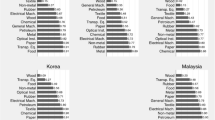Abstract
A common feature in the empirical literature of intra-industry trade is the analysis of trade between a given reference country and a set of partners. This article differs from previous studies by examining the bilateral trade among all trading partners within a set of partners. Using a panel data approach, we find that differences in factor endowments seem not to be important as a driving force behind vertical intra-industry trade for European countries over the chosen period. More important driving forces are production size, geographical proximity, average income per capita and income distribution overlap.
Similar content being viewed by others
Notes
More precisely, Mora (2002) investigates high-quality VIIT.
In the case of Germany, we use Frankfurt am Main.
References
Arellano, M. (1993). On the testing of correlated effects with panel data. Journal of Econometrics, 59(1/2), 87–97.
Aturupane, C., Djankov, S., & Hoekman, B. (1999). Horizontal and vertical intra-industry trade between Eastern Europe and the European Union. Weltwirtschaftliches Archiv/Review of World Economics, 135(1), 62–81.
Barro, R., & Lee, J. W. (1993). International comparisons of educational attainment. Journal of Monetary Economics, 32(2), 363–394.
Benhabib, J., & Spiegel, M. (1994). The role of human capital in economic development: Evidence from aggregate cross-country data. Journal of Monetary Economics, 34(2), 143–173.
Coe, D. T., & Helpman, E. (1995). International R&D spillovers. European Economic Review, 39(5), 859–887.
Copeland, B. R., & Kotwal, A. (1996). Product quality and the theory of comparative advantage. European Economic Review, 40(9), 1745–1760.
Crespo, N., & Fontoura, M. P. (2004). Intra-industry trade by types: What can we learn from Portuguese data? Review of World Economics/Weltwirtschaftliches Archiv, 140(1), 52–79.
Davis, D. R. (1995). Intra-industry trade: A Heckscher-Ohlin-Ricardo approach. Journal of International Economics, 39(3), 201–226.
Durkin, J. T., & Krygier, M. (2000). Differences in GDP per capita and the share of intra-industry trade: The role of vertically differentiated trade. Review of International Economics, 8(4), 760–774.
Falvey, R. E. (1981). Commercial policy and intra-industry trade. Journal of International Economics, 11(4), 495–511.
Falvey, R. E., & Kierzkowski, H. (1987). Product quality, intra-industry trade and (Im)perfect competition. From In H. Kierzkowski (Ed.), Protection and competition in international trade. Oxford: Basil Blackwell.
Flam, H., & Helpman, E. (1987). Vertical product differentiation and North-South trade. American Economic Review, 77(5), 810–822.
Fontagné, L., & Freudenberg, M. (1997). Intra-Industry Trade: Methodological Issues Reconsidered. (CEPII Working Paper No. 97-01). Paris: Centre D’Etudes Prospectives et d’Informations Internationales.
Frees, E. W. (2001). Omitted variables in Longitudinal Data Models. Canadian Journal of Statistics, 29(4), 573–595.
Frees, E. W. (2004). Longitudinal and panel data: analysis and applications in the social sciences. Cambridge: Cambridge University Press.
Greenaway, D., Hine, R., & Milner, C. (1995). Vertical and horizontal intra-industry trade: A cross industry analysis for the United Kingdom. Economic Journal, 105(433), 1505–1518.
Grubel, H. G., & Lloyd, P. J. (1975). Intra-industry trade: The theory and measurement of international trade in differentiated products. London: MacMillan Press.
Gullstrand, J. (2002a). Does the measurement of intra-industry trade matter? Weltwirtschaftliches Archiv/Review of World Economics, 138(2), 317–339.
Gullstrand, J. (2002b). Demand patterns and vertical intra-industry trade with special reference to to North-South Trade. Journal of International Trade and Development, 11(4), 429–455.
Hausman, J. A. (1978). Specification tests in econometrics. Econometrica, 46(4), 1251–1271.
Hausman, J. A., & Taylor, W. E. (1981). Panel data and unobservable individual effects. Econometrica, 49(6), 1377–1398.
Hsiao, C. (2003). Analysis of panel data. Cambridge: Cambridge University Press.
Jensen, L., & Lüthje, T. (2008). Country specific effects of differences in factor endowments on intra-industry trade—illustrated by the Danish case. Global Business and Finance Review, 13(1), 35–46.
Leamer, E. (1984). Sources of comparative advantage. Cambridge, MA: MIT Press.
Liang, K., & Zeger, S. L. (1986). Longitudinal data analysis using generalized linear models. Biometrika, 73(1), 13–22.
Linder, S. B. (1961). An essay on trade and transformation. Stockholm: Almqvist & Wiksell.
Lüthje, T. (2003). Is intra-industry trade in reality two-way trade? Global Business and Finance Review, 8(1), 89–102.
Martín-Montaner, J. A., & Ríos, V. O. (2002). Vertical specialization and intra-industry trade: The role of factor endowments. Weltwirtschaftliches Archiv/Review of World Economics, 138(2), 340–365.
Mora, C. D. (2002). The role of comparative advantage in trade within industries: A panel data approach for the European Union. Weltwirtschaftliches Archiv/Review of World Economics, 138(2), 291–316.
Murphy, K. M., & Shleifer, A. (1997). Quality and trade. Journal of Development Economics, 53, 1–15.
Nielsen, J. U.-M., & Lüthje, T. (2002). Tests of the empirical classification of horizontal and vertical intra-industry trade. Weltwirtschaftliches Archiv/Review of World Economics, 138(4), 587–604.
Stokey, N. L. (1991). The volume and composition of trade between rich and poor countries. Review of Economic Studies, 58(1), 63–80.
Venables, A. J., Rice, P. G., & Stewart M. (2003). Topics in Economic Analysis and Policy, 3(1):1–23.
White, H. (1980). A hetroskedastictity-consistent covariance matrix estimator and a direct test for hetroskedasticity. Econometrica, 48(4), 817–838.
Zhang, J., van Witteloostuijn, A., & Zhou, C. (2005). Chinese bilateral intra-industry trade: A panel data study for 50 countries in the 1992–2001 period. Weltwirtschaftliches Archiv/Review of World Economics, 141(3), 510–540.
Acknowledgments
We acknowledge helpful suggestions and comments by the anonymous reviewer.
Author information
Authors and Affiliations
Corresponding author
About this article
Cite this article
Jensen, L., Lüthje, T. Driving forces of vertical intra-industry trade in Europe 1996–2005. Rev World Econ 145, 469–488 (2009). https://doi.org/10.1007/s10290-009-0022-5
Published:
Issue Date:
DOI: https://doi.org/10.1007/s10290-009-0022-5




